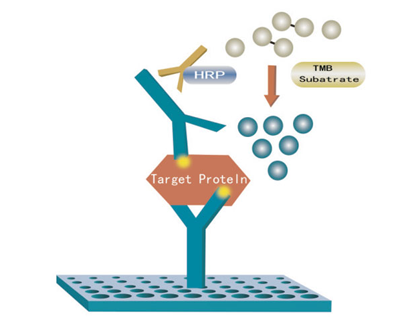in
Elisa kitIn operation, we all think that the principle of the ELISA experiment seems to be very simple, no more than fixed antigen, adding primary antibody, secondary antibody and substrate, mixed with washing and blocking. However, even the bland washing and sealing, if not done well, may ruin the entire experiment. At the end of the experiment, whether we can get meaningful information depends largely on the signal-to-noise ratio of the results. Background noise can affect your judgment of the results. How to reduce the background of the ELISA, there are some tips below.
 First, washing is very important
First, washing is very important The washing step may seem boring, but it is important because if unbound material (such as non-specifically bound antibodies or detection reagents) remains in the microplate, it will increase background noise. If necessary, increase the salt concentration in the wash solution, which will prevent non-specific binding reactions. If the background is too high and you suspect that the wash is not enough, try increasing the number of washes.
Second, the closure is more critical
The role of the blocking solution is to allow unrelated proteins to occupy potential binding sites in the microplate. This reduces the chance of non-specific binding of antibodies that produce signals. Of course, you also want antibodies to bind only to the protein of interest. If your background is too high and you suspect that the closure is not adequate, you can try a higher concentration of blocking solution or extend the closure time appropriately.
If you have been plagued by background issues, then maybe you should spend some time optimizing the sealant. This may take time, but it is also worth it. There are currently two main types of blocking fluids: protein and non-ionic detergents. The type you use depends on several factors, including the surface reagents of the microplate, the adsorbed antigen, your antibodies, and the test reagents. A good blocking solution should reduce non-specific binding, but it should not interact with antigens, antibodies or detection reagents.
The most commonly used nonionic detergent is Tween-20. This blocking solution is inexpensive, stable, and useful for removing some non-specific binding during the washing process. But they only work when they exist, because they are easy to wash off. Therefore, a blocking solution must also be added to all washing solutions. Do not use high concentrations (normal concentrations of 0.01-0.1%), which will reduce specific binding and produce false negatives. Another option is to use two blocking solutions, protein and non-ionic detergents, which assist in the closure during the washing process.
Protein blocking solutions are different and permanent. They bind to and block the open site while stabilizing the antigen molecules that bind to the microplate. Commonly used protein blocking solutions include bovine serum albumin (BSA), skimmed milk powder, normal serum and fish gelatin. The intrinsic diversity of serum components allows it to effectively intercept many different types of molecular interactions. However, it has the disadvantage of being able to interact with Protein A and IgG antibodies. One way to solve this problem is to use normal serum from chicken or fish.
Third, the antibody concentration must be optimized
We usually follow the steps left by the brothers and sisters, but if the reagents are slightly different, you may need to optimize the amount of antibody. Keep in mind that non-specific antibody binding increases background. To prevent this, do not use too much primary or secondary antibody.
Fourth, the detection reagent should be appropriate
Another point is also obvious: don't use too much testing reagents. If the concentration is too high or not diluted properly, it will result in a high background. Also don't overexpose, if necessary, optimize when you should add stop solution.
If your ELISA kit operation unfortunately encounters a high background, then don't worry too much, look at the components in the ELISA system in turn, and eliminate possible problems. Careful optimization, I believe that there will be beautiful results soon.
KNLN6-63 Residual Current Circuit Breaker With Over Load Protection
KNLN6-63 TWO FUNCTION : MCB AND RCCB FUNCTIONS
leakage breaker is suitable for the leakage protection of the line of AC 50/60Hz, rated voltage single phase 240V, rated current up to 63A. When there is human electricity shock or if the leakage current of the line exceeds the prescribed value, it will automatically cut off the power within 0.1s to protect human safety and prevent the accident due to the current leakage.
leakage breaker can protect against overload and short-circuit. It can be used to protect the line from being overloaded and short-circuited as wellas infrequent changeover of the line in normal situation. It complies with standard of IEC/EN61009-1 and GB16917.1.
KNLN6-63 Residual Current Circuit Breaker,Residual Current Circuit Breaker with Over Load Protection 1p,Residual Current Circuit Breaker with Over Load Protection 2p
Wenzhou Korlen Electric Appliances Co., Ltd. , https://www.zjmotorstarter.com
